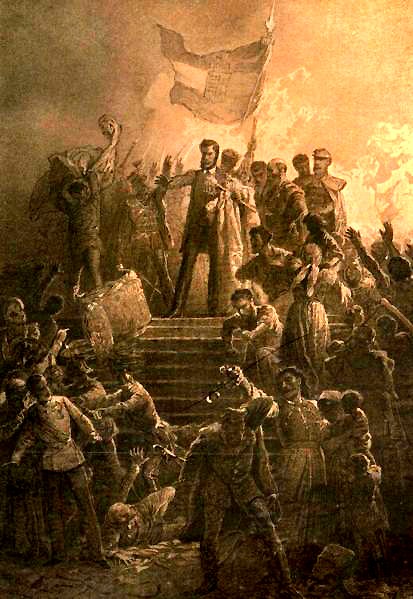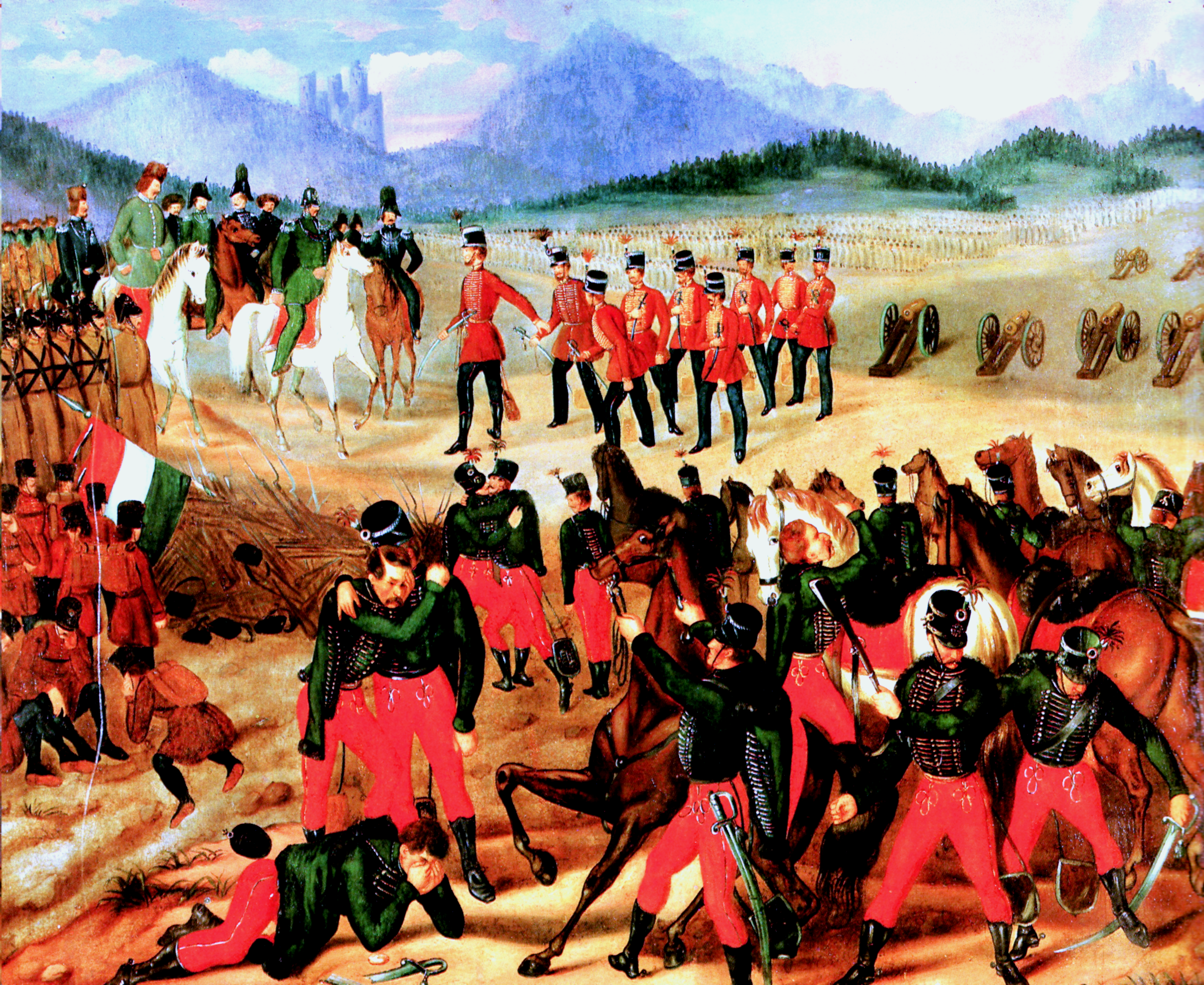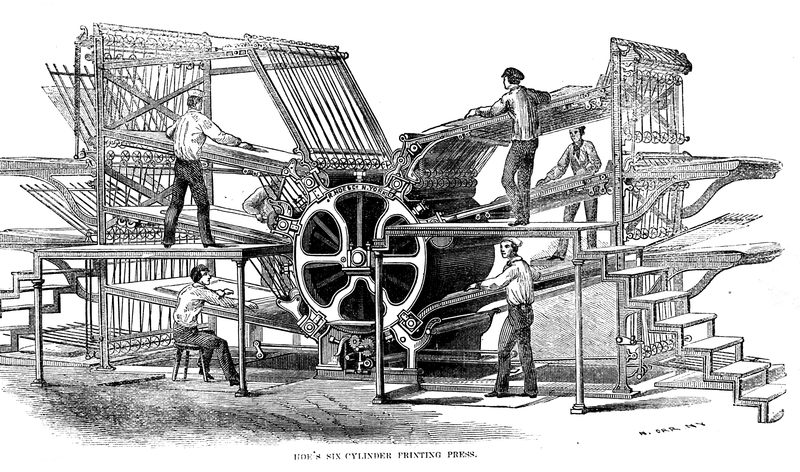The European Revolutionary Years (1844-1848)
After the defeat of Rome, the eyes of the world was now focused on Spain and it's dispute with Britain over the Mahgreb region. With France's declaration of war in support of Britain, it's ally, the fate of Spain was effectively sealed.
Spain
Spain is attacked in a carefully planned two pronged invasion of Maghreb by the British and of Spain by France. The first stage was the defeat of the Spanish Navy.
The aftermath of the battle is shown below
The Battle for Spain was superbly planned by the French
The Second French Army found it's battles in the basque region easy and took all the cities. Also the amphibious landing supported by the French fleet allowed the French Third Army to march onto Seville, but the First French Armies seige on the Capital was more difficult and lost the majority of its forces in the retreat.
Mahgreb
The British broke out of Tunis with a reinforced army and easily defeated the Spanish forces, who were severely hampered by their ally al-Qadir al-Jaza'iri who was defeated at Isly in Morocco by the Sultan of Morocco.
note: Forgot about the revolver upgrade, but it did not really affect the outcome
France
The "February Revolution" in France was sparked by the suppression of the campagne des banquets. This revolution was driven by nationalist and republican ideals among the French general public, who believed that the people should rule themselves.
Italy
The 1848 Siciliy revolution was substantially organized from, and centered in, Palermo. The popular nature of the revolt is evident in the fact that posters and notices were being handed out a full three days before the substantive acts of the revolution occurred on 12 January, 1848.

The other 1848 revolutions in the Italian states were organized revolts in the states of Italy led by persons who desired a liberal government and wanted to get Italy rid of the French presence. During this time period, Italy was still not a unified country, and was divided into many states, which, in Northern Italy, were ruled by the French. A desire to be free from foreign rule, led the Italian people to stage a revolution in order to drive out the French. The revolution was led by the state of Piedmont, one of the four states where the French leaders were forced to grant liberal rights. Also, the uprisings in the Kingdom of Lombardy–Venetia, particularly in Milan, forced a French General to retreat to the Quadrilatero fortresses.
But with the successes in Spain, these revolutions had minimal impact on France itself.
Germany
The "March Revolution" in the German states took place in the south and the west of Germany, with large popular assemblies and mass demonstrations. They primarily demanded German national unity, freedom of the press, freedom of assembly, arming of the people and a national German parliament.
Hungary
The Hungarian Revolution of 1848 was one of many revolutions that year and closely linked to other revolutions of 1848 in Central Europe. The revolution in the Kingdom of Hungary grew into a war for independence.
The German ruler and his advisors skillfully manipulated the Croatian, Serbian and Romanian peasantry, led by priests and officers firmly loyal to the a Greater Germany, and induced them to help fight against the Hungarian government. The Hungarians were supported by the vast majority of the Slovak, German, Rusyn and Hungarian Slovenes nationalities, as well as by the Jews of the kingdom, and by a large number of Polish, Austrian and Italian volunteers.
In June 1848 German troops entered Hungary heavily outnumbering the Hungarian army. After all appeals to other European states failed, Kossuth abdicated on August 11, 1848 in favor of Artúr Görgey, whom he thought was the only general who was capable of saving the nation. On August 13, Görgey signed the surrender at Világos (now Şiria, Romania) and handed the army over to the Germans.
A couple of attempts to influence the leaders of the Gold Coast to let settlers arrive were rejected, because of situation in Europe and they did not want any part in it.
Bosnia
Bosnia continued its assertion of control over Turkey and saw fit to build additional factories whichboasted the local economy and the poulation soon forgot about the Italian experience and is looking forward to a bright and peaceful future.
Russia
The peoples of the Idel-Urals, fearing the revolutions of Europe, joined the Russain peoples in solidarity in the hopes of keeping peace and prosperity.
Scandavania
March 8, 1844 – King Oscar I ascends to the throne of Sweden-Norway. and a new era is begun.
Denmark
Denmark had been governed by a system of absolute monarchy since the seventeenth century by the SRO died in January 1844 during a period of rising opposition from farmers and liberals. The demands for constitutional monarchy, led by the National Liberals, ended with a popular march to Christiansborg, where the new king, met the liberals demands and installed a new Cabinet that included prominent leaders of the National Liberal Party.
Livonia
Becomes independent again.
C.S.A.
May 24,1844 – The first electrical telegram is sent over the telegraph by Samuel F. B. Morse from the Washington to the B&O Railroad "outer depot" in Baltimore, Maryland, saying "What hath God wrought".
June–July – The Great Flood of 1844 hits the Missouri River and Mississippi River.
California
In 1846, the Rotary printing press invented in California, making rapid printing of newspapers possible.
Mexico
The Republic of Yucatán separates for a second time from Mexico.
But this separation does not last long and the Californians take back control soon after.
Texas
On February 27, 1844 – The Dominican Republic, which had a factory built by the Texans, gains independence from Haiti.
Tawantinsuyo
Tawantinsuyo was able to take over the remainder of Brazil and also Paraguay decided to join.
Mughal Empire
The Emperor of the Mughals became really strong and it's influence spread to parts of Bengal who joined the empire.
Afghanistan
The Afghani representatives have been able to convince the rest of the Sind Province to join with Afghanistan
Iran
May 23, 1844 – Persian Prophet The Báb privately announces his revelation to Mullá Husayn, just after sunset, founding the Bábí Faith (later revolving to the Bahá'í Faith as the Báb intended) in Shiraz.
Caliphate of Medina
Medina's has successfully taken control of Egypt and was also able to build a factory in Syria, which has strengthened it's control over that province.
Horn of Africa
An additional factory has been built and control of Nigeria has been achieved.
Swaziland
The northern tribes of Zambia continued to ignore the ovetures by the Swazis, but remainder Sahel decided to join them.
Southern Han
The Han dynasty continued its industry build up.
Xi'an
After considerable efforts by the government increased order and stability was achieved.
Siam
Malaya successfully secedes to Siam. Attempts to influence the Philippines was not successful, as you'll read below.
Japan
Taiwan joins Japan and also gains a factory, however, like Siam it was also not successful.
The Philippines
A civil war broke out between the north and south, which often pitted brother against brother and father against son, which was fanned by outside forces. This war reached a stalemate, and the Filipinos decided to rid themselves of these outside forces and build a strongly independent nation and two new cities were formed in the north and the south of the country.
Australia
Australia's investment continues in Indonesia, adding to its industrial output. After the signing of the Treaty of Waitangi with the remainder of the NZ Maori tribes two more cities were founded in New Zealand. The Pacific islands also joined, making Australia the pre-eminent power in the South Pacific.
Map
corrections made
Quickstats
corrections made
Note: I hope you like my first attempt. Map editting took the longest, followed by the individyual nation developments and then the actual battles themselves. All told about 6-7 hours actual work.



















